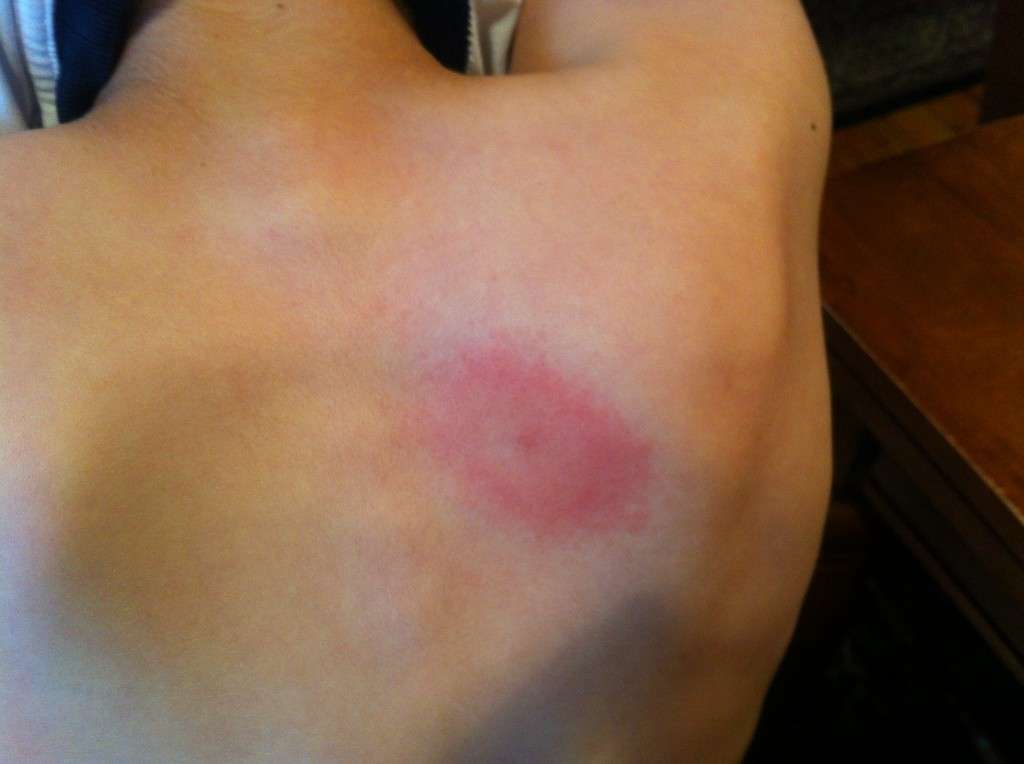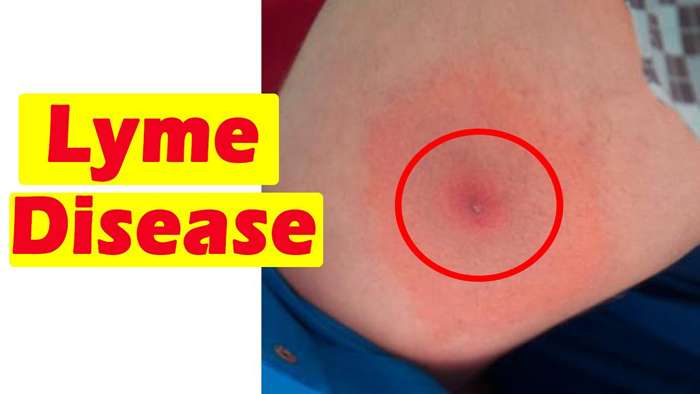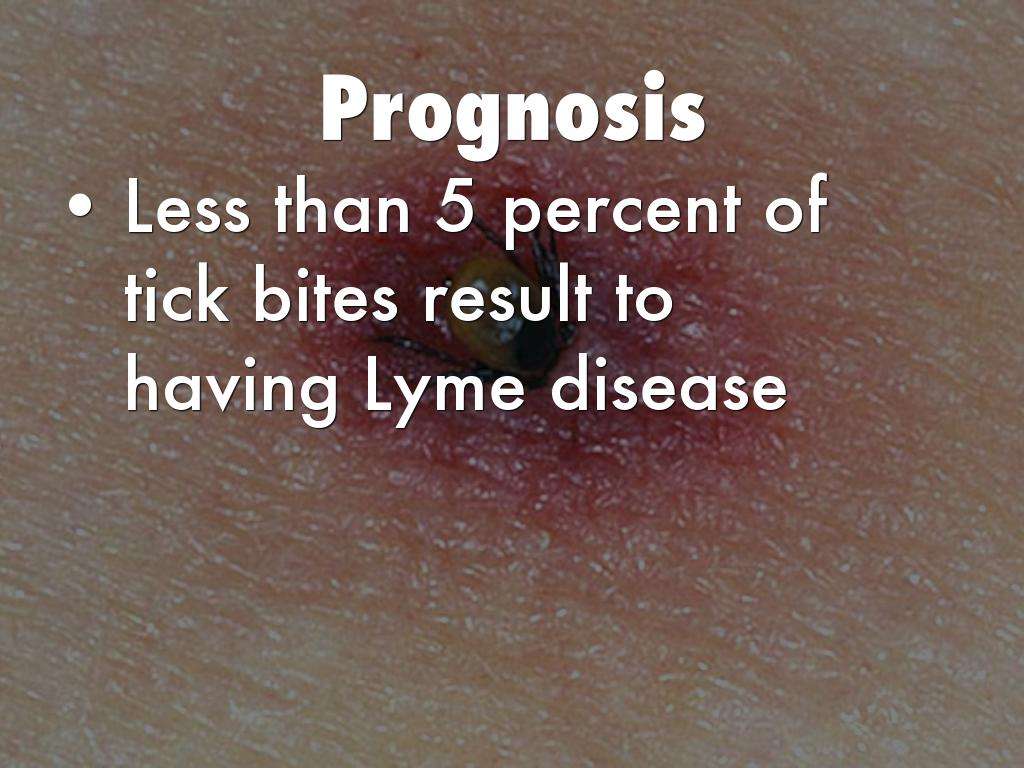Lyme Disease Frequently Asked Questions
If you have not done so already, remove the tick with fine-tipped tweezers.
The chances that you might get Lyme disease from a single tick bite depend on the type of tick, where you acquired it, and how long it was attached to you. Many types of ticks bite people in the U.S., but only blacklegged ticks transmit the bacteria that cause Lyme disease. Furthermore, only blacklegged ticks in the highly endemic areas of the northeastern and north central U.S. are commonly infected. Finally, blacklegged ticks need to be attached for at least 24 hours before they can transmit Lyme disease. This is why its so important to remove them promptly and to check your body daily for ticks if you live in an endemic area.
If you develop illness within a few weeks of a tick bite, see your health care provider right away. Common symptoms of Lyme disease include a rash, fever, body aches, facial paralysis, and arthritis. Ticks can also transmit other diseases, so its important to be alert for any illness that follows a tick bite.
References:
Moody KD, Barthold SW, 1991. Relative infectivity of Borrelia burgdorferi in Lewis rats by various routes of inoculation.external iconAm J Trop Med Hyg 44: 135-9.
There are no reports of Lyme disease being spread to infants through breast milk. If you are diagnosed with Lyme disease and are also breastfeeding, make sure that your doctor knows this so that he or she can prescribe an antibiotic thats safe for use when breastfeeding.
How Is Lyme Disease Diagnosed
To make a diagnosis, your health care provider will consider:
- Your symptoms
- How likely it is that you were exposed to infected blacklegged ticks
- The possibility that other illnesses may cause similar symptoms
- Results of any lab tests
Most Lyme disease tests check for antibodies made by the body in response to infection. These antibodies can take several weeks to develop. If you are tested right away, it may not show that you have Lyme disease, even if you have it. So you may need to have another test later.
What Are The Signs & Symptoms Of Lyme Disease
Lyme disease can affect different body systems, such as the nervous system, joints, skin, and heart. The symptoms of Lyme disease are often described as happening in three stages. Not everyone with Lyme has all of these, though:
The rash sometimes has a “bull’s-eye” appearance, with a central red spot surrounded by clear skin that is ringed by an expanding red rash. It also can appear as an growing ring of solid redness. It’s usually flat and painless, but sometimes can be warm to the touch, itchy, scaly, burning, or prickling. The rash may look and feel very different from one person to the next. It can be harder to see on people with darker skin tones, where it can look like a bruise. It gets bigger for a few days to weeks, then goes away on its own. A person also may have flu-like symptoms such as fever, tiredness, headache, and muscle aches.
Read Also: Iv Antibiotics For Lyme Disease
How Is Lyme Disease Diagnosed And Treated
Lyme disease is usually diagnosed when a person develops a bull’s-eye rash, flu-like symptoms , or both. These symptoms usually start a few days or weeks after the person is bitten by an infected tick.
A two-step blood test can verify the presence of Lyme disease antibodies, although it does take a few weeks for those antibodies to develop. And despite what some physicians and advocacy groups claim, a blood test is the only way Lyme disease can be confirmed, Larry Zemel, MD, head of rheumatology at Connecticut Childrens Medical Center, tells Health. Some doctors say they can diagnose Lyme even when patients test negative repeatedly, but that has not been borne out by any scientific study, he says.
When people are diagnosed with Lyme disease in its early stages, a 10- to 20-day course of oral antibioticsusually with a drug called doxycyclinewill clear the infection and help them feel better fairly quickly. This cures the vast majority of people, and they have a 100% recovery with no lasting effects, says Dr. Zemel.
If Lyme disease isnt diagnosed right away, it can cause more serious symptoms like arthritis and memory problems. These people may need a full month of oral antibiotics, says Dr. Zemel. About 20% of these patients will need IV antibiotics , and they may also need other medications to treat symptoms like pain and muscle stiffness.
RELATED: The Bestand WorstWays to Remove a Tick From Your Skin
How Can Lyme Disease Last For Years

Category: Health Published: October 9, 2015
If treated, Lyme disease does not last for years. However, for some people, the after-effects of the disease can linger for months and sometimes even years. Alternative medicine providers call this condition “Chronic Lyme disease,” but this title is simply wrong. For a person who has been infected with Lyme disease and then treated, the bacteria that causes Lyme disease is measurably no longer present in his body, even though he may still feel some symptoms. The correct title for this condition is therefore “Post-treatment Lyme Disease Syndrome.”
Lyme disease is an infection caused by a bacteria known as Borrelia burgdorferi. This bacteria is delivered to humans through tick bites. From the bite site, the bacteria can enter the bloodstream and spread throughout the body. Usually, but not always, an infectious tick bite causes a characteristic red rash at the site of the bite. Other symptoms include fever, muscle soreness, headache, fatigue, and dizziness. In a few cases, symptoms can also include mood swings, memory loss, and sleep disturbance. If left untreated for too long, Lyme disease can lead to nerve damage, thereby causing shooting pain, numbness, and even paralysis.
The CDC states,
Recommended Reading: What Are The Signs Of Lyme Disease In A Dog
What Happens At Your Appointment
The GP will ask about your symptoms and consider any rash or recent tick bites you know about.
Lyme disease can be difficult to diagnose. It has similar symptoms to other conditions and there’s not always an obvious rash.
2 types of blood test are available to help confirm or rule out Lyme disease. But these tests are not always accurate in the early stages of the disease.
You may need to be retested if you still have Lyme disease symptoms after a negative result.
When Should I Call The Doctor
If a tick bites you, call your doctor. Other conditions can cause similar symptoms, so it’s always a good idea to discuss them with your doctor. That way you can get checked and treated, if needed. Call right away if you get a red-ringed rash, lasting flu-like symptoms, joint pain or a swollen joint, or facial paralysis.
You May Like: Ivermectin Dose For Lyme Disease
Deer Tick Lyme Disease Rash
Lyme disease is the most common vector-borne disease in the United States. Lyme disease is caused by the bacterium Borrelia burgdorferi and rarely, Borrelia mayonii.It is transmitted to humans through the bite of infected blacklegged ticks. Typical symptoms include fever, headache, fatigue, and a characteristic skin rash called erythema migrans. If left.
What Happens If Chronic Lyme Disease Is Left Untreated
When you think you have been bitten by a tick, its important to schedule an appointment at Kotsanis Institute of Functional Medicine with Dr. Constantine Kotsanis. When left untreated, chronic Lyme disease can cause memory loss, inflammation around your heart and throughout your body, nerve damage, autoimmune disease, and other long-term heart problems. The good news is that Lyme disease is treatable, especially when we catch symptoms early in Grapevine, TX. We have successfully administered medication with Lyme disease treatment to our patients to rid their bodies of this infection.
Also Check: How To Test Ticks For Lyme Disease
What Is Lyme Disease
Lyme disease is the leading tick-borne disease in the United States. It’s most common in the Northeast, the Pacific Northwest, and the northern midwestern states.
Lyme disease is caused by a type of found in animals like mice and deer. Deer ticks that feed on these animals can then spread the bacteria to people through tick bites.
You probably won’t see it happening. Deer ticks are tiny, so it’s very hard to see them. Immature ticks are about the size of a poppy seed. Adult ticks are about the size of a sesame seed.
It’s easy to overlook a tick bite. Many people who get Lyme disease don’t remember being bitten. The good news is that most tick bites don’t lead to Lyme disease. But it still helps to know what to watch for.
Will Lyme Disease Go Away If Left Untreated
Left untreated, signs and symptoms of the primary illness usually will go away on their own within a few weeks, although the rash may recur. Days to months later, additional symptoms of Lyme disease may occur. The organs affected later in the course of the disease may lead to the following conditions and complications:
Don’t Miss: Beach House Rentals Old Lyme Ct
How Long Does Lyme Disease Last
Lyme disease symptoms can begin anywhere from three to 30 days after transmission of the infection from a tick. If treated early on with antibiotics, most people feel better within a few weeks, says Dr. Zemel.
According to the CDC, its not uncommon for people to experience lingering symptoms like fatigue and joint or muscle pain for a few weeks or months after treatment. Additional antibiotics wont help these symptoms, however, and most people improve on their own over time.
In a small percentage of cases, people continue to experience symptoms for more than six months after their recommended course of antibiotics is completed. This is sometimes referred to as chronic Lyme diseasebut that name is misleading, says Dr. Kuritzkes, because there is no evidence that the bacteria that causes Lyme disease is still present in the body. Instead, the CDC refers to this condition as post-treatment Lyme disease syndrome .
As with many other kinds of infectious diseases, some people are left with some debilitating symptoms that dont go away, says Dr. Kuritzkes. I like to compare it to polio: Some people who had polio are left paralyzed, but that doesnt mean they have chronic polio they have permanent damage from the infection, even after its gone away.
Its possible that Lyme infection leads to some damage that we dont fully understand yet, Dr. Kuritzkes adds. But we do know that long-term or repeated courses of antibiotics have no benefit in these cases.
Stage : Early Localized Lyme Disease

Stage 1 or early localized Lyme disease occurs 128 days following a tick bite.
Some people with stage one Lyme disease do not experience any symptoms. If symptoms do occur, they may include the following:
- a skin rash that may or may not resemble a bulls-eye
- flu-like illness, including chills and a fever
- swollen lymph nodes
You May Like: Old Lyme Bed And Breakfast
The Chance Of Getting Lyme Disease
Not all ticks in England carry the bacteria that causes Lyme disease.
But it’s still important to be aware of ticks and to safely remove them as soon as possible, just in case.
Ticks that may cause Lyme disease are found all over the UK, but high-risk places include grassy and wooded areas in southern and northern England and the Scottish Highlands.
Ticks are tiny spider-like creatures that live in woods, areas with long grass, and sometimes in urban parks and gardens. They’re found all over the UK.
Ticks do not jump or fly. They attach to the skin of animals or humans that brush past them.
Once a tick bites into the skin, it feeds on blood for a few days before dropping off.
Stage : Late Disseminated Lyme Disease
Stage 3 or late disseminated Lyme disease is the final stage of the disease. A person may enter this stage if they did not receive treatment for Lyme disease in the early stages, or if their symptoms persisted despite treatment. As such, doctors sometimes refer to this stage as chronic or post-treatment Lyme disease .
Stage 3 Lyme disease can occur after an infected tick bites a person.
A person with stage 3 Lyme disease may experience additional symptoms, including:
- severe joint pain and swelling, known as chronic Lyme arthritis
- heart palpitations or irregular heartbeat, due to Lyme carditis
- inflammation of the brain and spinal cord
- mental fogginess
Recommended Reading: Herbs That Kill Lyme Disease
Risk Factors For Post
Youre at a greater risk for post-treatment Lyme disease syndrome if youre infected by the bite of a diseased tick. If the infection progresses to the chronic stage, your symptoms might continue for weeks, months, or even years after the initial tick bite.
You may also be at a higher risk for these long-term symptoms if youre not treated with the recommended antibiotics. However, even people who receive antibiotic therapy are at risk. Because the cause of post-treatment Lyme disease syndrome is unknown, theres no way to determine whether it will progress to the chronic stage.
Typically, the symptoms of post-treatment Lyme disease syndrome resemble those that occur in earlier stages. People with persistent symptoms often experience lingering episodes of:
- fatigue
Effects Of Untreated Lyme Disease
When left untreated, Lyme disease can be debilitating. When it isnt treated early, it can spread and go into hiding in different parts of your body. Weeks, months, or years later, it can cause problems with your brain, nervous system, heart and circulation, digestion, muscles or joints, reproductive system, or your skin. While symptoms may disappear randomly, other ones may appear at different times. This is known as post-treatment Lyme disease or chronic Lyme disease.
Also Check: Lyme Literate Doctors In Nh
Learn More About Lyme Disease Treatment
When you suspect youve been bitten by a tick, its important to seek help from Dr. Constantine Kotsanis at the Kotsanis Institute of Functional Medicine. He has years of experience treating patients that may have been infected by a tick. He understands the seriousness of Lyme disease treatment and is committed to ensuring his patients stay as healthy as possible, even after a tick bite. He can offer diet, nutritional supplements, and other tips to maintain your health after Lyme disease.
Learning how to protect yourself from ticks is important since you can get Lyme disease more than once in your life, so clearing an infection doesnt make you immune to getting it again. However, Lyme disease is curable, in most cases, so getting effective Lyme disease treatment will help resolve your symptoms.
Why Are Antibiotics The First Line Of Treatment For Lyme Disease
The use of antibiotics is critical for treating Lyme disease. Without antibiotic treatment, the Lyme disease causing bacteria can evade the host immune system, disseminate through the blood stream, and persist in the body. Antibiotics go into the bacteria preferentially and either stop the multiplication of the bacteria or disrupt the cell wall of the bacteria and kill the bacteria . By stopping the growth or killing the bacteria the human host immune response is given a leg up to eradicate the residual infection. Without antibiotics, the infection in Lyme disease can evade the host immune system and more readily persist.
Also Check: When To Test For Lyme Disease
How Long Does It Take For Lyme Disease To Kill You
Lyme disease can become chronic, and people will need to get hospitalized at that stage. Under normal circumstances, if treated with antibiotics, the disease goes away in three to seven days. The antibiotics are essential to kill the harmful bacteria and stop it from multiplying to avoid future complications.
When To See A Doctor

A person should see a doctor if they have recently received a tick bite. It is not possible to know whether a tick is carrying Lyme disease, and the symptoms may take weeks to appear.
The earlier a person receives a diagnosis and treatment, the higher the likelihood of a quick and complete recovery.
It is not always possible for a person to tell if a tick has bitten them. As such, people should also see a doctor if they experience any Lyme disease symptoms. A doctor will ask about the persons symptoms and duration and whether the person has spent time in tick-infested areas.
Also Check: Can Lyme Disease Cause Liver Damage
Does Lyme Disease Ever Go Away
Ask U.S. doctors your own question and get educational, text answers â it’s anonymous and free!
Ask U.S. doctors your own question and get educational, text answers â it’s anonymous and free!
HealthTap doctors are based in the U.S., board certified, and available by text or video.
What Is Late Lyme Disease
Lyme disease, also known as Lyme borreliosis, is caused by an infection with the bacteria Borrelia burgdorferi. This bacteria is disseminated through tick bites. Infected ticks usually bite small mammals, who do not develop any kind of infection from the bacteria. When humans are exposed to B. Burgdorferi from a tick bite, however, they can develop Lyme disease.
People who work outside or spend time in woodland areas, where there is greater potential for exposure to tick bites, are most at risk of infection.
Lyme disease is a condition which progresses in stages:
Recommended Reading: Lyme Disease Blood Test Cost